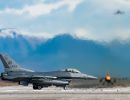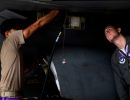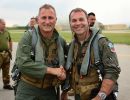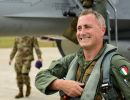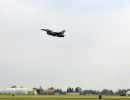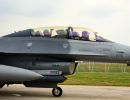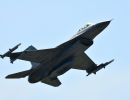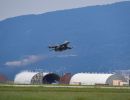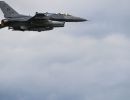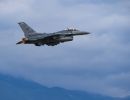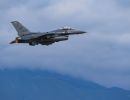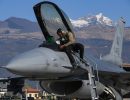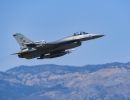Operation Northern Watch is a US European Command Combined Task Force (CTF) charged with enforcing the United Nations mandated no-fly zone above the 36th parallel in Iraq. The mission also entails monitoring Iraqi compliance with UN Security Council directives. The coalition partners of the United States, United Kingdom, and Turkey provide approximately 45 aircraft and more than 1,400 personnel to support Operation Northern Watch. The joint U.S. force of some 1,100 US personnel, includes sailors, soldiers and airmen from the Air Force, Army, Navy and Marine Corps. The original mandate from the Turkish government allowed the operation to continue for 6 months. Turkey subsequently approved two 6-month extensions, but indicated that it would not become a permanent mission.
Though the majority of the U.S. contingent is made up of Air and Space Expeditionary Forces on three month tours, Operation Northern Watch is a Combined Task Force which includes active duty Army, Navy, Marine and Air Force members as well as National Guard and reserve troops on 14 to 180 day tours. It has a 700 percent annual turn-over rate in personnel, with more than 9,000 cycle through Northern Watch each year.
The task force includes more than 50 U.K. and U.S. aircraft assigned. Coalition fighters, tankers, intelligence, surveillance and reconnaissance assets work as a team to enforce the no-fly zone. Missions require a mix of aircraft and on any given day could include: EA-6B Prowler, E-3 Sentry AWACS, F-15C, F-15E, F-16CJ, F-16CG, HH-60, HC-130, KC-135 Stratotanker, UH-60 Blackhawk, EP-3, C-12, British GR-3 Jaguar, Nimrod and VC-10 Tankers.
U.K. and U.S. aircraft fly patrol missions over Iraq an average of 18 days each month. By the end of November 2002, coalition forces have flown 106 days in the Northern No-Fly Zone. In 2001, they flew 146 days over northern Iraq and in 2000, they flew 164 days. Nearly every mission, they are under fire and threatened by elements of the Iraqi integrated air defense system. Anti-aircraft-artillery fire is the most common threat and is usually seen firing from two to five different locations.
Operation Northern Watch is the successor to Operation Provide Comfort, which officially ended in December, 1996. With the closing of the Military Coordination Center in 1996 the Secretary of Defense approved a modification of the mission in Northern Iraq. Since 1991, Operation PROVIDE COMFORT had provided humanitarian assistance to the Kurds and enforcement of the northern no-fly zone.
The enforcement of the No Fly Zone continued for almost two years witnessing a change for the worse in Iraq’s compliance with United Nation’s (UN) resolutions. Specifically Security Resolution 687, requiring Iraq to dispose of its weapons of mass destruction ballistic missiles with a range over 150 kilometers, and related production facilities and equipment. Since ONW started, Iraq grossly interfered with any progress made by UN arms inspectors on three separate occasions.
The first of these occurred on 13 November 1997 when Iraq expelled U.S. arms inspectors only to see them returned one week later.
On 13 January 1998, Iraq banned UN arms inspectors led by an American to continue their work forcing their expulsion three days later. This resulted in a build up of troops and an 11th hour mission by UN Secretary-General Kofi Annan geared toward convincing Iraq in signing a tentative deal allowing full access to suspected Iraqi weapon sites.
Finally on October 31, 1998, the Iraqi government suspended cooperation with UN Inspectors who were forced to withdrawal on 7 November 1998. With this, military units in the U.S. prepared for deployment under operation DESERT THUNDER. After some diplomatic wrangling, Iraq backed down and agreed to let UN weapons inspectors do their work.
One month later, a report summarizing a continued history of uncooperative actions and violations of the weapons of mass destruction disposal requirements broke the proverbial straw on the camel’s back. This resulted in Operation DESERT FOX, a four-day long military response in which ONW aircraft stood down to make way for aircraft designated for the contingency to reach their targets.
Shortly after the conclusion of DESERT FOX, Iraq announced they would no longer recognize the Northern and Southern no-fly zones. When the ONW mission resumed, Iraqi assets built for air defense went on the offensive as they shot at coalition aircraft with surface to air missiles on 28 December 1998. This act of aggression threatened the lives of the aircrew who responded in turn. This action resulted in the first delivery of ordinance over Northern Iraq by coalition forces since August of 1993. Ever since, Iraq anti aircraft assets continue to antagonize and threaten the coalition aircraft with weapon systems not belonging above the 36th parallel in the first place, prompting aircrews to respond to such hostile acts.
The results of these engagements have resulted in a severe loss of Iraq’s integrated air defense systems with all coalition aircraft returning to base safely, despite a $14,000 bounty by the Iraq leader himself to anyone who downed a coalition aircraft.
All the while, the relationship between the participating nations of ONW strengthened as they signed a unilateral agreement in February 1999 in the form of America’s first multi-national rules of engagement to be followed above the 36th parallel in Iraq, still being put into practice today.
On 15 September 1997, USAFE inactivated the 7440th and activated the 39th Air and Space Expeditionary Wing (ASEW) in its place. The ASEW concept sought to organize deploying squadrons into a familiar structure, and relied on temporary duty augmentees to provide adequate numbers of personnel to support the mission. A colonel dual-hatted as the commander of both the 39 WG and the 39 ASEW, exercised administrative control over all USAF forces assigned to the task force.
In the year covering June 1998 to June 1999 Combined Task Force personnel participated in the most intense combat operations in eight years employing 485 weapons, to include the first ever US combat use of the AGM-130, against 225 targets by way of over 5,000 combat/combat support sorties. Such accomplishments most recently earned ONW CTF the Joint Meritorious Unit Award (June 98 - 31 Dec 98).

























